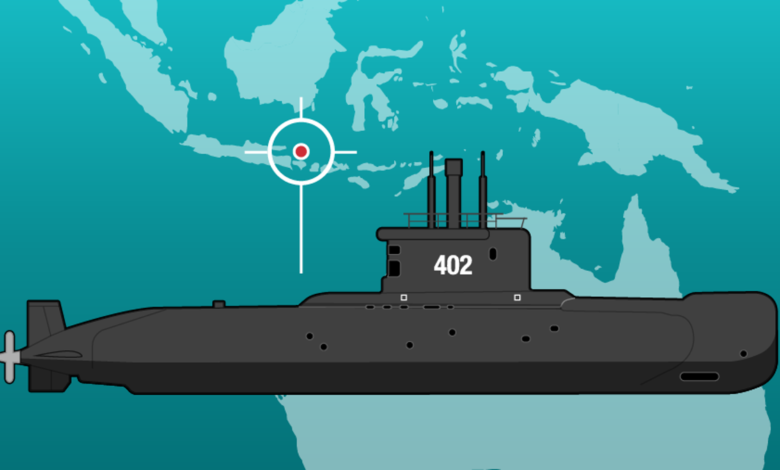

The oxygen supply is running desperately low aboard a missing Indonesian submarine with 53 crew aboard, believed sunk in deep water north of Bali.
Indonesian search teams have identified an area where the submarine may be located, CNN reported Friday. A navy ship found an object 164 to 328 feet below the surface, about 25 miles north of Bali, where an oil slick can be seen.
“We will maximize the effort today, until the time limit tomorrow at 3 a.m.,” when the oxygen on the sub is likely to have been completely depleted, military spokesperson Maj. Gen. Achmad Riad told reporters Friday. A news conference was scheduled for later Saturday morning.
The sub disappeared Wednesday morning 60 miles north of Bali after a military exercise, Indonesia's navy said. At the time, officials believed that the sub was more than 2,000 feet deep, making recovery impossible, authorities said.
While the new location raised hopes the sub is not as deep as feared, the situation remains dire. The 44-year-old German-made sub does not have an emergency docking collar on it that would allow a rescue submersible to attach itself and allow the crew to safely exit, naval authorities said.
The Associated Press reported that Indonesia’s navy continues to search as a sonar-equipped Australian warship arrived Friday to help. The U.S. is sending "airborne assets" to assist, Reuters said.
The KRI Nanggala-402 sub was thought to be as deep as 2,000 to 2,300 feet, a depth that threatens to crush the vessel.
Ahn Guk-hyeon, an official from South Korea’s Daewoo Shipbuilding and Marine Engineering, told the AP that the collapse depth for the submarine was 200 meters (656 feet) when Daewoo refitted the vessel's internal structures and systems in 2009-2012.
The submarine disappeared early Wednesday morning during a military exercise. An oil spill near its last position could indicate fuel tank damage, or be a signal from the sub's crew, the Indonesian navy said.
The submarine was conducting a torpedo drill when contact was lost. It's believed to be in the Bali Strait, a water channel between Bali and Java.
Frank Owen, secretary of the Submarine Institute of Australia, said the submarine could be at too great a depth for a rescue team to operate.
Owen, a former submariner who developed an Australian submarine rescue system, said the Indonesian vessel was not fitted with a rescue seat around an escape hatch designed for underwater rescues. He said a rescue submarine would make a waterproof connection to a disabled submarine with a so-called skirt fitted over the rescue seat so the hatch can be opened without the disabled submarine filling with water.
Twenty-one warships, three submarines, and five airplanes are searching for the sub, CNN reported. Singapore, Malaysia and India have each sent submarine rescue ships, according to the United States Naval Institute.
Navies from the U.S., Australia, France, and Germany have offered to assist.
The KRI Nanggala-402 sub is one of five operated by the Indonesian navy. It was built in 1977 by Howaldtswerke-Deutsche Werft, a German company. Indonesia bought it in 1981.
The sub went into service in 1981. It is a vintage Cakra-class vessel built by the former West Germany during the Cold War. It has been used by more than a dozen navies over the past five decades, including those from Argentina, Greece, India and Turkey.
Asian news organizations cited analysts who say that the nearly half-century old sub underscores the dangers of Indonesia’s decrepit military equipment.
Collin Koh, a research fellow at the Institute of Defence and Strategic Studies in Singapore, told the South China Morning Post that the submarine went missing in “no small part [due to] aging military hardware, though submarine accidents can also be attributed to human factors – errors in operating the boat, or even erroneous maintenance work done on the boat while moored alongside."
The missing submarine was last refurbished in 2012.
Zachary Abuza, professor of Southeast Asia studies at the Washington-based National War College, told the South China Morning Post that the warm waters around Indonesia can take its toll on the nation's sub fleet.
“Submarines last fewer years in tropical waters due to the warmer water, and Indonesia doesn’t have a great track record of caring for its ships,” he said.
SOURCE USA TODAY Network reporting and research; Associated Press; Reuters
Desperate hunt for Indonesian submarine as oxygen set to run out
Officials say air supply of missing submarine would last only until Saturday as search team spots ‘high magnetic force’ at a depth of 50-100 metres.
Aljazeera, Aljazeera
Published
Updated
Source link






